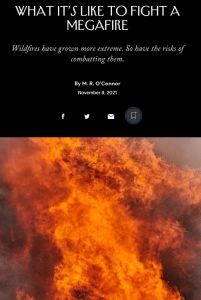
Article
What It's Like to Fight a Megafire
Wildfires have grown more extreme. So have the risks of combatting them
The New Yorker,
2021
Recommendation
Writing for the New Yorker, M. R. O’Connor describes wildfires from a statistical perspective – number of acres burned, number of dollars spent, number of lives lost – and from a boots-on-the-ground firefighting perspective informed by her personal experiences as a wildfire fighter. Reporting from the front lines of crisis management, O’Connor posts a tragic warning about the increasing difficulty of fighting massive megafires and about fiery hazards facing planet Earth if climate change remains unchecked.
Summary
About the Author
Certified wildland firefighter M.R. O’Connor’s books include Resurrection Science and Wayfinding. Her next book, Ignition, is about fire ecology.








Comment on this summary